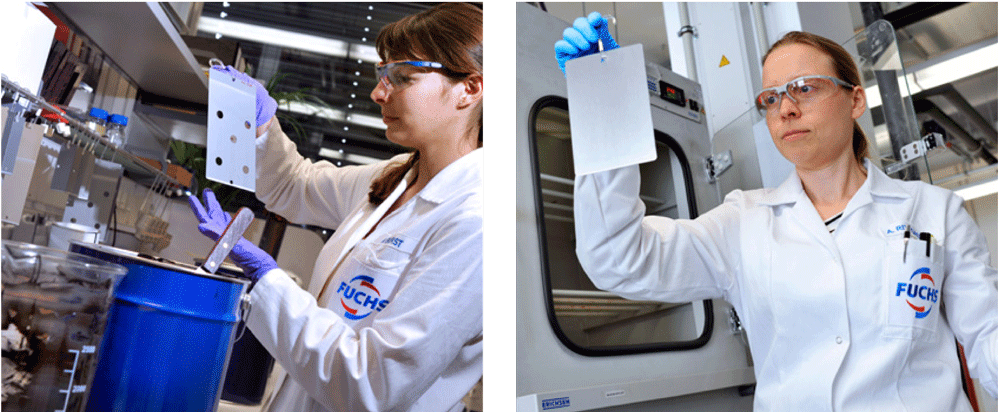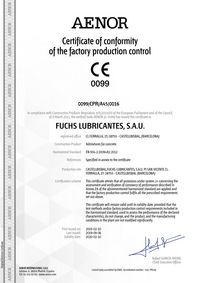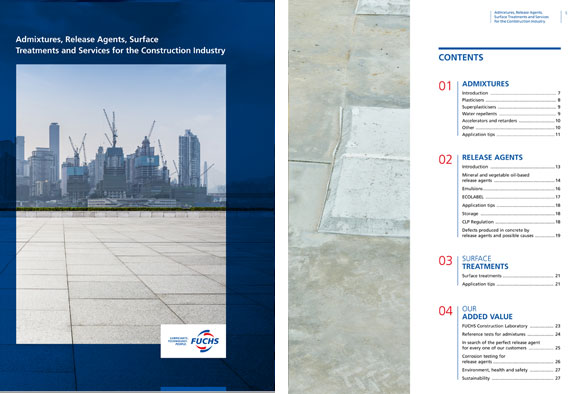FUCHS Construction Laboratory
We have our own R&D laboratory with extensive research potential and over 40 years of experience, which works closely with other R&D teams in the FUCHS group.

Constant cooperation with our customers, technology centres and other players in the construction industry enables us to anticipate market needs by creating products and services that offer sustainable and innovative solutions.
Occluded air test: UNE-EN 12350-7
Determination of the amount of air entrapped in a fresh concrete sample expressed as a percentage using the manometer method.
This test consists of placing a concrete sample, with an unknown volume of air, into a sealed air chamber that applies a known volume of air and pressure.
The percentage of air contained in the concrete is measured with the aid of a manometer.
From the results obtained, we develop admixtures that meet the air limits established for concrete according to its use.
Strength test: UNE-EN 12390-3
Determines the compressive strength of concrete specimens using a hydraulic press. It is a destructive test (DT) that gives us a highly reliable value for the compressive strength of concrete.
Setting time test: UNE-196-3
The setting of concrete is an exothermic chemical reaction that measures the hardening time that occurs when cement and water come into contact.
During the general hardening process the mixture initially loses its plasticity and becomes difficult to handle, this state is called "initial setting". As the normal hardening of the mixture takes place, the consistency reaches a very appreciable level: the final setting.
The Vicat automatic needle system allows us to quantify the setting time. This information is required for the development of accelerators and retarders, as well as other admixtures such as superplasticizers.
Water-repellent testing UNE-EN 934-2
Following the EN 480-5 standard, a test is carried out that helps us to determine the capillary absorption of concrete.
Concrete with low capillary action ensures greater resistance against efflorescence and stains caused by water or humidity, as well as preventing seepage.
We carry out other complementary tests such as the waterresistance and efflorescence test DIN 5211 (UNE EN 83830).
Slump-flow test (UNE-EN 12350-8:2011)
Measurement of the flow time of a self-compacting fluid concrete. This test makes it possible to measure slump flow of concrete and its consistency.
J-ring test (UNE-EN 12350-12:2011)
Determination of passing ability. This procedure shows the ability of concrete to pass through the spaces between the reinforcement.
V-funnel test (UNE-EN 12350-9:2011)
This test determines the time it takes for the concrete to flow through a V-shaped funnel. In this way, the segregation resistance of self-compacting concrete is calculated.
Release agents are highly complex products of crucial importance to the surface quality of concrete and the cleaning of formwork. For this reason, we dedicate all our expertise, technology and resources to finding the most suitable release agent for each client in order to:
- reduce time and operating costs;
- optimize the process;
- obtain concrete surfaces without flaws or stains;
- achieve clean, dust-free, corrosion-free and longer-lasting moulds;
- find the most sustainable solution, with the least possible environmental impact.
Our value proposition is to optimize the use of release agents for our customers, without affecting their production process and by taking care of all testing and application phases.
We work closely with our customers. The proximity of our laboratory allows us to perform various custom tests with their aggregates and cements in order to study compatibility with each type of concrete.
Concrete/release agent compatibility
Release agents react differently with concrete depending on their chemical nature.
At our laboratory, a test designed by our R&D team is carried out to observe the interface behaviour and reaction and compatibility of the release agent with the concrete usually used by the customer.
This test mainly prevents poor air removal and the formation of surface bubbles that cause problems with finishes as commonly found by FUCHS technicians and which they solve without difficulty.
Release test
We have numerous moulds of different materials and shapes that allow us to replicate the technical requirements of our customers.
In the case of vertical moulds we can test different types of releasing and curing by applying different percentages of humidity and temperatures.
In addition to observing the behaviour of the release agent on this type of surface, we can check the result that the unit will have in the corners and whether there could be any danger of chipping or breaking.
In order to extend the life of moulds, beds and formwork and to prevent damage to the concrete caused by corrosion, we also carry out corrosion tests on steel in our laboratory in order to analyse and determine the ability of our release agents to protect against corrosion.
Corrosion test (DIGIGALV TEST)
This test consists of immersing two electrodes in a sample of release agent and, using the Digigalv instrument, a current is created between the two that allows us to measure the difference in current intensity.
This test enables us to obtain the rate of corrosion that occurs, as well as its type.
Bleed water corrosion test
Study of the protection in sheet steel against bleeding water from the water and cement mixture provided by the customer.
The results obtained are more accurate as we replicate our customers' process conditions to a greater extent.
Filter paper corrosion test (IP-287)
Determination of the rust prevention properties of release agents and rust prevention techniques when they are mixed with water.
The IP-287 standard specifies the method for assessing the potential rusting of metal components during manufacturing operations where release agents are used. The test lasts for two hours, using standardized metal chips placed on filter paper, where any rust produced is visible.
Cast iron corrosion test (IP-125)
Following the IP-125 standard, the corrosion characteristics of the product on cast iron are analysed. Two metals are placed in contact for 16 hours in controlled temperature and humidity conditions. This test enables us to assess the amount and type of corrosion produced and improve the ability of a release agent to prevent corrosion.
Salt Spray Chamber ASTM B117 - 18
The salt spray test consists of recreating a controlled corrosive atmosphere, with the aim of accelerating the corrosion process in metals and being able to develop highly effective release agents that operate under harsh environmental conditions.






